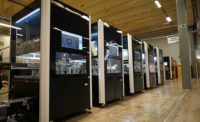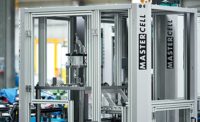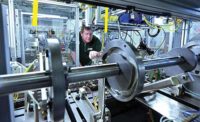Many companies are rearranging their assembly operations into cells. According to an Industry Week survey, 19 percent of U.S. manufacturers practiced cellular manufacturing last year. In addition, when plant managers were asked what lean practices they rated as "extremely effective," cellular manufacturing was singled out by the greatest number of respondents—50 percent.
Cellular manufacturing is loosely defined as small-batch production of parts, subassemblies or final assemblies using machines grouped closely together into cells. Often arranged in a U shape, cells are typically dedicated to a narrow range of highly similar products. Ideally, the cells contain all the equipment and resources necessary to assemble their products.
The list of potential benefits of cellular manufacturing is impressive. It can reduce inventories of work in process (WIP) and finished goods. It can decrease both setup time and throughput time. And, it can improve product quality and increase flexibility.
That said, cellular manufacturing is not for everyone, nor does it always produce the desired results. Equipment underutilization is one potential drawback, and the strategy may be at odds with traditional cost-accounting methods or union work rules. And while manufacturers may have little difficulty arranging machines closer together, the real trick is achieving continuous flow.
To learn the real story about cellular manufacturing, ASSEMBLY magazine hosted a panel discussion at the Assembly East show in May in Fort Washington, PA. Key personnel from four leading regional manufacturers argued the pros and cons of this critical manufacturing strategy. The panelists were:
- Jack Czajkowski, vice president of operations for Stryker Howmedica Osteonics (Rutherford, NJ), a manufacturer of artificial joints and other medical devices.
- James H. Curren, integrated product team and support cell manager with Boeing Military Aircraft and Missile Systems (Ridley Park, PA).
- Don Mingos, senior manufacturing engineer with the Productivity Solutions Group at Ingersoll-Rand Co. Tool & Hoist Div. (Athens, PA).
- John Vitellaro, a senior manufacturing engineer with Lockheed Martin Naval Electronics and Surveillance Systems (Archibald, PA).
Q: Why did your company consider cellular manufacturing? What benefits have you seen from it?
Czajkowski: Our big challenge was inventory. We make hip and knee replacement joints, and doctors have to bring a lot of different parts to surgery. We can’t afford to keep all those parts in inventory. At the same time, we can’t afford any delays in shipping. Since we implemented cellular manufacturing, 98 percent of our customers can expect same-day shipment. Costs have been reduced by 10 percent annually since 1992, while sales per employee have more than doubled.
Mingos: Over the past 15 years, we converted our entire facility to cellular manufacturing. Both WIP and finished product inventories have been reduced by more than 50 percent, and manufacturing cycle time has been reduced by more than 75 percent. So it’s been a drastic change to our way of life.
Curren: For us, cells grew out of Boeing’s overall approach to lean manufacturing. One of the main drivers was inventory. The cost of keeping a lot of inventory adversely affected our ability to bid for jobs. If we were to compete, we had to take a lean approach to the whole facility. With the help of cellular manufacturing, we went from a push system to a pull system. Now, we only keep one shift-set of parts inventory in the queue, which opened up a lot of extra floor space for us to take on more work.
We build the Apache and Chinook helicopters, as well as the V-22 Osprey, and we intermingle their production now. It’s not segregated. We are better able to use our people with the work in cells. Training is a lot easier.
Vitellaro: We realized that if we didn’t start reducing costs, we risked losing a $10 million program from the Navy. How do you reduce cost? Eliminate waste. How do you eliminate waste? One way is through cellular manufacturing. When we were done, we went from 8,000 square feet to 2,700 square feet, and all the cells feed each other. We went from carrying $4 million of WIP inventory per day to $180,000 per day. As a result, not only did we keep that $10 million program, we also secured an additional $80 million in business to build other things.
Q: Did converting to cellular manufacturing result in job losses?
Curren: Yes, we eliminated a lot of inventory management jobs, and we got out of the fabrication business. But, better than half of everyone who lost their job was placed into an assembly position. We retrained folks who had been here 15 to 25 years and done nothing but run machine tools or control parts inventory. These people made a commitment to us, so we owed it to them to bring them into the assembly arena.
Q: What incentives do you use to get workers to embrace cellular manufacturing?
Curren: We organized employee involvement (EI) teams for each cell. We also instituted gain-sharing systems for each aircraft program. Incentives are handled not so much by team, but by whole aircraft programs or by the whole plant. When we first started, morale was at an all-time low. But now it’s starting to be embraced and people are running with it. We’re moving into a new $30 million facility dedicated to the V-22 Osprey, and the entire layout was designed by the workers from the floor.
Czajkowski: Our incentive is continued employment! You can talk about cellular manufacturing with your workforce, but in some cases, you have to do it, or you’re out of business.
Q: How long does it take to implement cellular manufacturing?
Czajkowski: It depends on the organization. I’ve implemented cellular manufacturing in a union plant, where I’m at now, and in a nonunion shop.
In the nonunion shop, our people absolutely embraced it. Within a year, we saw the mind-set turn around. The people who were the problem were the exempt and salaried staff, because we put them into cells, too.
If you’re unionized, it takes a little longer. We had to agree to a memorandum of understanding with the union as to what flexibility meant, what the expectations were, and how much people could move around. The real militant union people on the floor gave us a hard time. But we worked through it.
Curren: Boeing is a union shop, and we had to build cellular manufacturing into the contract, including the gain-sharing system. We grade each team by level of achievement. We’re almost at the point now where we can give each team a daily metric to meet, such as defects. We meet for a minimum of an hour each week to talk issues. Approximately 84 percent of our workforce is in EI teams, and our goal is to have 100 percent. There is an incentive to be an EI leader. EI leaders earn an additional 75 to 80 cents per hour.
Q: How do you organize EI teams?
Curren: Each cell has its own team. At first, we tried to organize teams by skill: sheet-metal assemblers, airframe builders, aircraft electricians, aircraft mechanics. However, once we started moving the work into cells, we had aircraft electricians and mechanics working within the same cell, so we got away from skill-based teams and organized teams by cell or shop. When you do that, you often get a lot of new ideas. An electrician may have a suggestion for mechanical installation.
At the lower pay grades, our contract allows us to combine electricians and mechanics jobs into a new job—aircraft assembler. Workers in that job can do everything up to splicing wires or hydraulic tubing. They can do the initial routes. In our next contract, we’re going to push for more cross-training to give us more flexibility.
Czajkowski: We require extensive cross-training. Our goal is to have each worker spend 5 percent of the year in cross-training. For each skill, every team member is rated as to whether he can’t do it, he can do it with help, he can do it fully, or he can teach others to do it. Then, every month, the teams have to report on their progress. How many people know all the different tasks? How many people have progressed to the next block?
According to our agreement with the union, anyone can be asked to do a higher skill level, but they can’t be disciplined if they can’t do it. And, they can be required to do an equal or lower skill job. That gives us a lot of flexibility in the shop.
Curren: We involve both line workers and line supervisors, and you have to listen to their ideas. Once they saw that their ideas were embraced, there was no resistance. And, a lot of their ideas made sense. After all, these people are touching the product every day. Now that the teams are in place, my biggest problem is involving the support organizations, such as engineering and quality.
Q: How do you work with suppliers to reduce inventory and implement just-in-time manufacturing?
Czajkowski: In some cases, such as forgings, inventory is kept on our floor on consignment. We get billed for it as we use it. In other cases, such as bar stock, our suppliers visit our plant regularly to replenish our racks. We let the suppliers determine the minimum and maximum levels.
Vitellaro: We work with our suppliers. We want them to realize the value of cellular manufacturing, too. When some of our suppliers get an order, they want to start cutting chips right away. They don’t know what it is to be lean. They don’t know about single-minute die exchanges to cut down on machining time. They’re still working on 4-hour setups for this machine and 3-hour setups for that machine. So, we tell them what we’re trying to do, and we share our knowledge with them.
Q: How has cellular manufacturing affected your inventory turns?
Vitellaro: Our goal is "take one, make one," but we knew we couldn’t do that right off the bat. We decided to keep 1 day of inventory on the floor, and 1 day behind it. That way, I have a 1-day cushion in case something happens. We’re not Toyota. Our suppliers are not all within a 100-mile radius of our plant. If a truck blows up on the way to the plant, my line’s down. We had to put some rules in place about clamping down on inventory.
Q: How do you integrate process departments, such as painting or injection molding, into workcells?
Vitellaro: We just bought a powder coat line. We brought the cell right to the paint line. We really wanted to bring the paint line to the assembly line, but we couldn’t do it.
After we installed the powder coat line, a new product came up that needed to be painted. However, after we considered setup Arial, we discovered that it was easier to get another paint booth than to go through constant changeover.
There’s no doubt that we have extra capability now, as a result of cellular manufacturing. SomeArial, a machine has to work at its own pace. A wave soldering machine or a reflow oven, for example. So you do have to maximize equipment utilization, and you may need to compromise. We have a process that requires a silver-filled, conductive epoxy. It’s very expensive, about $4 per gram. Within the required cycle time, we can only do four units before the batch is exhausted. So if I practice "take one, make one," I’m throwing out a lot of expensive chemicals.
But, don’t think I’m sitting back. I’m always on the lookout for an epoxy with a longer cure time. Once you set the rules, don’t be afraid to go back and change them.
Czajkowski: We’ve tackled that issue in two ways. The first option is always to get that process into the cell. We had a large heat-treatment furnace. Five cells fed it, and it had a 5-hour cycle time. Later, we found some furnaces that we could actually put in the cell, and now heat treatment is part of the takt time of the cell.
The other option is to treat that process as an in-house vendor. That’s how we handle our packaging department. Its takt time matches that of the feeder cells. The department’s performance is measured on turnaround time. Any part that hits its door by 5 p.m. must be ready to ship that night.
Vitellaro: We put our packaging equipment right into our cells. After we mapped out our processes, we found that workers were walking 1,486 feet to get a container! So you have to map out your factories! A spreadsheet analysis can help, too. You may find that there’s one part that you don’t want to be in business doing, because it upsets the whole apple cart.
Finally, you don’t need to go big. Equipment should always be the right size for what you’re doing.
Czajkowski: I agree. You need to look at the products that are coming off that process line. It may make sense to split some of them off into a less automated line.
Q: What’s the best way to justify cellular manufacturing? Traditional cost-accounting methods may be at odds with this approach! For example, it’s supposedly much more cost-efficient to make 1,000 widgets per hour than it is to make 1,000 widgets per day, even if that’s only what’s needed.
Czajkowski: Ask your accountants how much inventory you’re holding and the cost of carrying that inventory. You should be able to compare the cost of a day’s worth of inventory with the cost of an hour’s worth.
Vitellaro: You also need to look at setup Arial. If you’re still customizing every setup, if you don’t have tooling that you can just pop in and out, that mucks up the waters.
The standard banking formulas say that more inventory makes you a sound corporation. Those rules have to be rewritten. We have the same problem. We use a lot of standard accounting formulas, because that’s what the government accountants want to see. They want to count the parts and accrue the labor. So I show them. I have four parts in queue, 40 minutes worth of work. Do they care about 40 minutes worth of work? Well, no. So why are they counting it? Count what’s been shipped!
If the accountants force you to look at their black-and-white world, just remember that total cost is total cost. You don’t make any money making 10,000 metal parts. You make money shipping completed products.
Q: How do you know if a cell is working? What do you measure?
Mingos: We measure output, manufacturing cycle time and takt time. Our goal is to have our product when we need it. We still pay too much attention to minutes produced. That’s being pushed aside, but it’s hard to let go.
Curren: We measure the average flow for a particular cell, takt time, inventory and defects. We give each team a target, and we post the results so each team can see how it’s doing. We look for repetitive defects. If the same defect pops up three or four Arial in a row, that may trigger an engineering change or a job sequence change.
Czajkowski: Our primary metrics are quality-related: defects and scrap.
We also measure customer service level. We guarantee same-day shipment to our customers, no matter what they order, so each team is measured according to how well they meet that goal. If the customer orders 100 parts and we ship 99, that’s a 99 percent service level.
We measure lead time, which is the time a work order is cut in the shop to the time the product is available to the customer on the shelf.
We measure inventories of raw materials, WIP and finished goods.
And lastly, we look at cost reduction. Every team has an annual cost-reduction goal of 10 percent, and that’s not based on inflation. If their product cost is $10 this year, it’s must be $9 next year, and $8.10 the following year, ad infinitum.
Vitellaro: The best metrics are ones that employees can actually control. Don’t give them anything they can’t work with, and remember—it’s about eliminating waste. If you’re drifting away from where you want to be, you want immediate feedback. You don’t want metrics that are so far away that it takes 3 days to review them.
If the goal is to reduce inventory, then you want to monitor your cycles. How do you monitor your cycles? Kanban. Start bar coding things.
It’s OK to let the customer help drive your metrics. If your customer is concerned about cycle time, then that’s something you want to look at.



